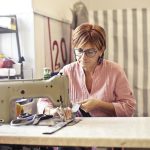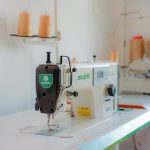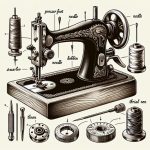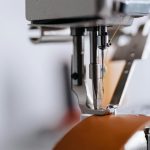When tackling vinyl upholstery, you need a sewing machine that can handle the challenge with finesse. Just like a reliable workhorse, the best sewing machine for vinyl upholstery should offer robust stitching power and speed to effortlessly navigate through thick layers. It should also provide needle and presser foot options suited for vinyl's unique properties.
Heavy-duty construction, adjustable tension, and a built-in walking foot are essential for seamless stitching. Specialized stitching options can elevate your upholstery projects to a professional level.
In this guide, you'll explore the key features to consider and the top sewing machine recommendations for mastering vinyl upholstery like a pro.
Key Takeaways
- A strong motor is essential for powerful stitching on vinyl upholstery.
- The sewing machine should have a walking foot mechanism for smooth stitching.
- Sturdy construction and metal components are important for durability.
- Consider the specific maintenance needs for vinyl upholstery when choosing a machine.
Key Features to Consider
When choosing a sewing machine for vinyl upholstery, you should look for a model that offers a strong motor and a walking foot mechanism to ensure smooth and precise stitching. Durability is crucial when working with tough materials like vinyl, so prioritize machines with a sturdy construction and metal components. A heavy-duty metal frame can withstand the demands of sewing through multiple layers of vinyl and prolonged use.
Additionally, consider the maintenance requirements of the sewing machine. Look for a model that's easy to clean and oil, as proper maintenance is essential for ensuring the longevity of the machine, especially when working with materials like vinyl that can put extra strain on the equipment. Some machines may have specific maintenance needs due to the nature of vinyl, so it's important to factor this into your decision.
Ultimately, a sewing machine with a strong motor, walking foot mechanism, durable construction, and manageable maintenance requirements is essential for effectively working with vinyl upholstery.
Stitching Power and Speed
To effectively stitch through vinyl upholstery, you need a sewing machine with powerful stitching capabilities and adjustable speed control. When considering stitching power and speed for vinyl upholstery, there are several key factors to keep in mind:
- Thread Thickness and Compatibility: Vinyl upholstery typically requires a heavier thread for durable and strong stitches. Look for a sewing machine that can accommodate thicker threads commonly used for upholstery work. Compatibility with heavy-duty threads ensures that the machine can handle the demands of sewing through vinyl without compromising stitch quality.
- Stitch Length Adjustment: The ability to adjust stitch length is crucial when working with vinyl upholstery. Sewing machines with adjustable stitch length settings allow you to customize the stitch length according to the thickness of the vinyl material. This feature is essential for achieving neat and secure stitches while working on various upholstery projects.
- Speed Control: A sewing machine with adjustable speed control provides the flexibility to match the stitching speed with the complexity of the upholstery project. This feature allows you to slow down the stitching speed for precise and intricate work, while also being able to increase speed for larger, straighter seams without sacrificing stitch quality.
Selecting a sewing machine with these features will ensure that you have the necessary stitching power and speed control to effectively work with vinyl upholstery.
Needle and Presser Foot Options
Consider the needle and presser foot options suitable for sewing through vinyl upholstery. When working with vinyl, it's crucial to choose the right needle and presser foot to ensure smooth, professional results. The type of needle and presser foot you use can significantly impact the quality of your stitching and the overall outcome of your project.
Needle Options
| Needle Type | Description | Best Use |
|---|---|---|
| Leather Needle | Designed with a wedge point to penetrate leather and vinyl without tearing the material | Ideal for sewing through multiple layers of vinyl upholstery |
| Heavy-Duty Needle | Features a strong shaft and sharp point for sewing through tough materials | Suitable for thicker vinyl fabrics and heavy-duty upholstery projects |
| Non-Stick Needle | Coated with a special non-stick surface to prevent adhesions and skipped stitches | Perfect for preventing adhesive buildup when working with vinyl |
Presser Foot Compatibility
| Presser Foot Type | Description | Best Use |
|---|---|---|
| Teflon Foot | Equipped with a non-stick coating to glide smoothly over sticky materials like vinyl | Ideal for preventing the presser foot from sticking to vinyl fabrics |
| Roller Foot | Contains rollers to help the foot move smoothly over difficult fabrics, reducing friction | Suitable for sewing through thick or sticky materials like vinyl upholstery |
| Walking Foot | Designed to evenly feed layers of fabric to prevent shifting and puckering | Perfect for maintaining even stitches when working with vinyl upholstery |
Selecting the appropriate needle and presser foot for your sewing machine is essential for achieving professional-looking results when working with vinyl upholstery. By considering the needle options and presser foot compatibility, you can ensure that your sewing machine is best suited for this particular task.
Heavy-Duty Construction
You need a sewing machine with heavy-duty construction for sewing vinyl upholstery. When considering heavy-duty construction, there are several key factors to take into account:
- Material Compatibility: Look for a sewing machine that's specifically designed to handle heavy-duty materials like vinyl. The machine should have a strong motor and sturdy frame to ensure it can handle the thickness and density of vinyl upholstery fabric without struggling.
- Stitching Precision: A heavy-duty sewing machine should offer precise stitching control. Look for features such as adjustable needle position, stitch length, and presser foot pressure. These features will allow you to achieve clean and even stitches on the tough vinyl fabric.
- Durability: A heavy-duty sewing machine should be built to last. Look for models with metal frames and components, as well as reliable and durable mechanisms for consistent performance over time.
When choosing a sewing machine for vinyl upholstery, heavy-duty construction is essential to ensure that the machine can handle the demands of working with thick and tough materials. Look for a machine that's specifically designed for heavy-duty sewing tasks and offers the features necessary for precision and durability.
Adjustable Tension and Presser Foot Pressure
How effectively can you adjust the tension and presser foot pressure on your sewing machine for working with vinyl upholstery?
When working with vinyl upholstery, it's crucial to have precise control over the tension and presser foot pressure to ensure clean, professional-looking stitches without damaging the material.
Adjustable tension allows you to fine-tune the tightness of the stitches, preventing puckering or loose stitches on vinyl, which is particularly sensitive to tension variations. Look for a sewing machine that offers easy adjustment of thread tension through a dial or digital controls.
Additionally, the ability to adjust the presser foot pressure is essential for working with vinyl. Too much pressure can leave marks or even puncture the material, while too little pressure can cause the fabric to slip and result in uneven stitches. A machine with adjustable presser foot pressure settings enables you to tailor the pressure to the specific requirements of vinyl upholstery.
When working with vinyl, consider using a longer stitch length and a specialized thread type designed for upholstery to achieve optimal results.
Built-In Walking Foot
Achieving precise control over the stitching process is facilitated by a built-in walking foot when working with vinyl upholstery on a sewing machine. The walking foot provides several benefits that make it essential for sewing vinyl upholstery:
- Even Feeding: The walking foot ensures that the layers of vinyl and backing fabric move together smoothly, preventing shifting or puckering during stitching.
- Reduced Slippage: Its built-in feed dogs grip the fabric from the top, working in conjunction with the sewing machine's feed dogs to minimize slippage and maintain consistent stitch length.
- Versatility: A sewing machine with a built-in walking foot can handle a wide range of fabrics, making it a versatile choice for various upholstery projects.
While the built-in walking foot is highly advantageous, some sewing machines offer walking foot alternatives, such as snap-on walking feet or compatible aftermarket walking feet. However, these alternatives may not always provide the same level of precision and control as a built-in walking foot.
When working with vinyl upholstery, investing in a sewing machine with a built-in walking foot can significantly enhance the quality and ease of your sewing projects.
Specialized Stitching Options
Consider incorporating specialized stitch options when sewing vinyl upholstery to enhance the durability and aesthetic appeal of your projects. Utilizing the right thread tension and stitch length can make a significant difference in the quality of your upholstery work. Here are some specialized stitching options that you can use with the recommended thread tension and stitch length for sewing vinyl upholstery:
| Stitch Type | Thread Tension | Stitch Length |
|---|---|---|
| Straight Stitch | High | 3mm – 3.5mm |
| Triple Stitch | Medium | 3mm – 4mm |
| Zigzag Stitch | Low | 1mm – 2.5mm |
| Topstitch | High | 3mm – 4mm |
Proper thread tension ensures that the stitches penetrate the vinyl evenly without causing bunching or loose stitches. Additionally, the right stitch length prevents the vinyl from puckering or stretching, resulting in a professional-looking finish. Experiment with these specialized stitching options, thread tension, and stitch length to achieve the best results for your vinyl upholstery projects.
Top Sewing Machine Recommendations
For sewing vinyl upholstery, you should look for a sewing machine with a heavy-duty motor. When selecting a sewing machine for vinyl upholstery, it's crucial to consider the machine's ability to handle heavy fabrics and provide consistent stitching. Here are three top sewing machine recommendations for working with vinyl upholstery:
- Sailrite Heavy-Duty Ultrafeed LSZ-1 Walking Foot Sewing Machine: This machine is specifically designed for heavy-duty sewing tasks and is well-known for its ability to handle thick materials like vinyl with ease. It comes with a powerful motor and a walking foot mechanism for smooth and even stitching.
- Janome HD3000 Heavy-Duty Sewing Machine: With a sturdy build and a powerful motor, this sewing machine is equipped to handle vinyl upholstery. It offers a range of features suitable for working with heavy fabrics, and it has received positive feedback from customers for its performance with vinyl.
- Brother ST371HD Strong and Tough Sewing Machine: This machine is praised for its ability to work on tough fabrics like vinyl. It features a heavy-duty metal frame and a strong motor, making it a reliable choice for sewing vinyl upholstery.
When working with vinyl upholstery, regular maintenance is essential to keep your sewing machine in optimal condition. Be sure to follow manufacturer's maintenance tips and troubleshooting guidelines. Additionally, consider comparing customer reviews to make an informed decision when selecting a sewing machine for your vinyl upholstery projects.
Frequently Asked Questions
Can a Regular Sewing Machine Handle Vinyl Upholstery, or Do I Need a Specialized Machine?
Yes, a regular sewing machine can handle vinyl upholstery, but it's best to use a machine with features like a walking foot, adjustable presser foot, and heavy-duty needles for better compatibility and results.
Are There Any Specific Maintenance Requirements for Sewing Machines Used for Vinyl Upholstery?
When working with vinyl upholstery, it's essential to follow specific maintenance requirements for your sewing machine. Regularly clean and lubricate the machine, use the appropriate needles and thread, and troubleshoot any issues promptly to ensure smooth operation.
What Type of Thread Is Best for Sewing Vinyl Upholstery?
For sewing vinyl upholstery, the best needles to use are heavy-duty or leather needles. Adjust your sewing machine tension to accommodate the thickness of the vinyl fabric. When choosing thread, opt for a heavy-duty polyester or nylon thread for best results.
Can a Beginner Use a Sewing Machine for Vinyl Upholstery, or Is It More Suitable for Experienced Sewers?
Yes, a beginner can use a sewing machine for vinyl upholstery. With the right techniques and maintenance, sewing vinyl upholstery can be beginner-friendly. Choose a sewing machine suitable for heavy-duty projects and practice on scrap fabric first.
Are There Any Specific Techniques or Tips for Sewing Vinyl Upholstery That I Should Be Aware Of?
When sewing vinyl upholstery as a beginner, it's essential to use the correct sewing machine techniques and handle challenges effectively. Ensure you have the appropriate needle and thread, use a walking foot, and practice on scrap material beforehand.
- How to Tell if Fabric Is Woven or Nonwoven - July 10, 2025
- The Complete Guide to Nonwoven Materials - July 10, 2025
- What Is a Nonwoven Textile? a Broad Definition - July 9, 2025







